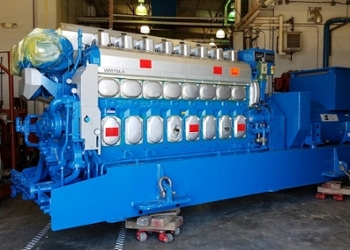Finland-based Company Donates Massive $500,000 Engine to Texas A&M Galveston

Trying to fix some loose bearings on an engine that’s the size of a school bus is a daunting task, but some Texas A&M University at Galveston students are learning engine repair that may come in handy one day when they are engineers aboard a ship on the high seas, thanks to a generous donation from a Finnish company.
Wartsila, a Finland-based company that makes engines for customers throughout the world, donated the massive 27-ton engine to the Galveston campus recently, and the $500,000 engine will give midshipmen some valuable practical experience as they seek their maritime licenses. The 20-foot-long engine serves as a learning lab as students improve their knowledge of engine repair, emissions and fuel economy for future use when they are sailing ships through oceans and ports around the world.
“This is a valuable learning and research tool for our students in several ways,” says Ed Clancy, professor of marine engineering and head of the Marine Engineering Technology Department at Texas A&M-Galveston.
“They learn the basics of the engine and how to do various repairs that they very well might need one day at sea. It’s not a mock-up – it’s a real 2,000-horsepower engine that can be found in tugs and ferry boats, just the kind of equipment our students will be working with once they graduate. It is an ideal tool for student education and for ongoing university research on marine power systems.”
Wartsila is a $5.3 billion company that employs 18,000 workers in over 70 countries. It specializes in building engines and generators for marine use and power plants and its headquarters are in Helsinki.
The diesel engine is currently housed in an engineering building on campus. When powered, students can learn how it operates and instructors can teach them the details of the various moving parts.
“It’s the first time we’ve had an engine like this in a lab setting, where students can work on it indoors,” adds Clancy.
“So what the students learn is very realistic and practical.”
Though similar, the engines are not quite as large as those used on the General Rudder, the school’s training ship that serves as a classroom on the sea that midshipmen learn to pilot during lengthy summer cruises they must take to earn their maritime licenses.
As students learn about the 2,000-horsepower engine, Clancy says that some cadets go to a different level: some of them have worked on 100,000-horsepower engines that are among the largest in the world.
The Texas A&M Maritime Academy is one of six state maritime academies in the United States and provides an opportunity for midshipmen to operate and maintain an ocean-going vessel and gain practical experience in seamanship, navigation and engineering operations. At the conclusion of their training program, cadets are examined to become licensed in the Merchant Marine as a deck or engineering officer and may seek employment in various fields of marine transportation.

 http://www.tamug.edu/news/2016articles/DonatedEngine.html
http://www.tamug.edu/news/2016articles/DonatedEngine.html